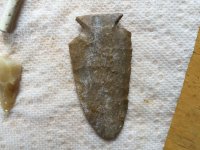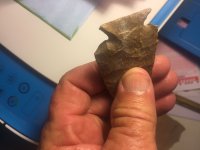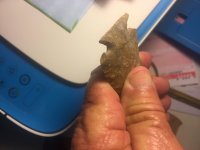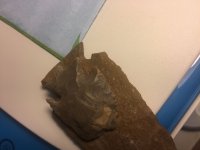Navigation
Install the app
How to install the app on iOS
Follow along with the video below to see how to install our site as a web app on your home screen.
Note: This feature may not be available in some browsers.
More options
You are using an out of date browser. It may not display this or other websites correctly.
You should upgrade or use an alternative browser.
You should upgrade or use an alternative browser.
Found an unusual point today
- Thread starter willjo
- Start date
Garscale
Bronze Member
Looks like it had nice ears that got dinged off. Sweet anyway.
Older The Better
Silver Member
- Apr 24, 2017
- 3,400
- 6,697
- Detector(s) used
- Whites Eagle Spectrum
- Primary Interest:
- All Treasure Hunting
That whole base looks odd to me but maybe it’s just the angle in the picture, kinda looks like one large removal for the entire base and one large removal to form each notch then just a few random small removals... maybe with the ears it would make sense
uniface
Silver Member
Decatur.
sandchip
Silver Member
- Oct 29, 2010
- 4,357
- 6,890
- Detector(s) used
- Teknetics T2SE
- Primary Interest:
- All Treasure Hunting
Need a close up of the breaks to make that determination, and usually the barbs, sides and bottom of the base are fractured in a Decatur. There should be a hinge on the notch side of those breaks, not just the barbs snapped off. I've seen Decaturs with only two fractures instead of six, but it's usually across the base, one inward from each side. Any fracturing on the base itself?
Last edited:
uniface
Silver Member
Decatur.
IMO.
IMO.
Tdog
Silver Member
I'll go with Kirk Corner Notched.
joshuaream
Silver Member
Decatur.
IMO.
Yes, and Yes.
sandchip
Silver Member
- Oct 29, 2010
- 4,357
- 6,890
- Detector(s) used
- Teknetics T2SE
- Primary Interest:
- All Treasure Hunting
Those are not fractured barbs, just snapped off. Respectfully, I'm not seeing anything about that point that's right for a Decatur, size, notch depth/shape/angle, but that's just my opinion too, for what little it's worth.
uniface
Silver Member
Gross morphology is very variable with Decaturs.
Bend-breaks in unlikely places and tranchet removals are visibly different.
It's the knapping technique used to create the base bottom, and sometimes notches also, that define the type and distinguish it from its contemporaries & later CNs..
FWIW
Bend-breaks in unlikely places and tranchet removals are visibly different.
It's the knapping technique used to create the base bottom, and sometimes notches also, that define the type and distinguish it from its contemporaries & later CNs..
FWIW
sandchip
Silver Member
- Oct 29, 2010
- 4,357
- 6,890
- Detector(s) used
- Teknetics T2SE
- Primary Interest:
- All Treasure Hunting
In addition to the points that I made, the area of distribution is somewhat removed from where willjo found his, not that that would alone discount the possibility of it being a Decatur, but it doesn't help, especially considering that the point has none of the typical characteristics of that type other than missing its barbs, coupled with the absence of the most important diagnostic feature of a base fractured by removal of two flakes inward across the base. I've only seen one Decatur from this area in my lifetime, roughly the same distance from the accepted area of distribution as willjo's, but it was correct in average size, it was serrated and beveled, but most importantly, it had the textbook fractured base. I value your comments as usual, but I'm afraid we'll just have to differ on this one, brother.
uniface
Silver Member
. . .
Last edited:
uniface
Silver Member
FWIW
From both corner edges after preliminary corner removals plus center notching. However, when the first removal runs completely across the edge of the base to the other corner, as sometimes happened, the result is one continuous tranchet flake surface, as willjo's example seems to show.
Add to this that in willjo's example, both notches appear to have been created (finished) by similar tranchet flake procedure (twice on one side, once on the other).
Both of these are Decatur procedures, distinguishing their work from that of other contemporary and later corner notches at a glance. Deliberate tranchet flaking is not their most important diagnostic feature -- it is their only diagnostic feature. Otherwise Decatur points show the same variation in notch angles, notching depth and blade shape (100% a matter of beginning width available and degree of resharpening) as other, contemporary points show over time and space.
The Early Archaic people got around to an extent that seems to surpass even Paleo people. E.g., Gary Fogelman finding a trade black of red & cream Paoli chert from Kentucky at the Warrior Springs site in Northumberland Co., Pennsylvania. Dick Savage (this is merely stuff found by people I know or knew, and saw personally) finding a large, ace-of-spades Decatur of bullseye hornstone (Dongala ?) in Union Co. Pa. and a friend of his finding a type 3 Hardaway of silicified tuff (North Carolina) at the forks of the Susquehanna River. For that matter, Early Archaic cornernotches of Blue Coshocton (Ohio) are commonly enough found around Lancaster and Eastern Pa. that it's a familiar lithic.
The all-time distance champ I've seen was a Scottsbluff of Hixton that GF got out of a farm collection from NE Pa., years ago.
Again, FWIW. Nobody -- me included -- knows it all, or pretends to.
the most important diagnostic feature of a base fractured by removal of two flakes inward across the base
From both corner edges after preliminary corner removals plus center notching. However, when the first removal runs completely across the edge of the base to the other corner, as sometimes happened, the result is one continuous tranchet flake surface, as willjo's example seems to show.
Add to this that in willjo's example, both notches appear to have been created (finished) by similar tranchet flake procedure (twice on one side, once on the other).
Both of these are Decatur procedures, distinguishing their work from that of other contemporary and later corner notches at a glance. Deliberate tranchet flaking is not their most important diagnostic feature -- it is their only diagnostic feature. Otherwise Decatur points show the same variation in notch angles, notching depth and blade shape (100% a matter of beginning width available and degree of resharpening) as other, contemporary points show over time and space.
The Early Archaic people got around to an extent that seems to surpass even Paleo people. E.g., Gary Fogelman finding a trade black of red & cream Paoli chert from Kentucky at the Warrior Springs site in Northumberland Co., Pennsylvania. Dick Savage (this is merely stuff found by people I know or knew, and saw personally) finding a large, ace-of-spades Decatur of bullseye hornstone (Dongala ?) in Union Co. Pa. and a friend of his finding a type 3 Hardaway of silicified tuff (North Carolina) at the forks of the Susquehanna River. For that matter, Early Archaic cornernotches of Blue Coshocton (Ohio) are commonly enough found around Lancaster and Eastern Pa. that it's a familiar lithic.
The all-time distance champ I've seen was a Scottsbluff of Hixton that GF got out of a farm collection from NE Pa., years ago.
Again, FWIW. Nobody -- me included -- knows it all, or pretends to.
sandchip
Silver Member
- Oct 29, 2010
- 4,357
- 6,890
- Detector(s) used
- Teknetics T2SE
- Primary Interest:
- All Treasure Hunting
...However, when the first removal runs completely across the edge of the base to the other corner, as sometimes happened, the result is one continuous tranchet flake surface, as willjo's example seems to show...
If I could see the flake removed across the base that you mentioned, we wouldn't be having this debate in the first place. I simply don't see it, even after going back numerous times and zooming in on the edge shots of the base. Maybe I'm just going blind...
Older The Better
Silver Member
- Apr 24, 2017
- 3,400
- 6,697
- Detector(s) used
- Whites Eagle Spectrum
- Primary Interest:
- All Treasure Hunting
The discussion is good for me I appreciate the extra info, I wasn’t aware of that kind of manufacturing technique.
Tdog
Silver Member
I understand there are many types in this Kirk Corner Notched cluster with all having many of the same characteristics and not to make excuses but sometimes, it is difficult to differentiate one from the other. I've returned to this thread several times trying to understand what I'm seeing (or in this case, what I'm not seeing). I've always thought a Decatur's base will have a notch-like appearance in the center because of the way it's been fractured from each corner via what I now understand is tranchet flake removal. I didn't take into consideration that one flake removal could travel all the way across the base and a subsequent flake removal was not necessary. Also, it seems that grinding can sometimes mask all the steps it took to create the base. This piece had a Decatur appearance at first glance to me but like sandchip, I couldn't see it and in my case, didn't know what I was looking at. Anyway, enough rambling and I stand corrected on my typology ID. Thank you Mr. Bill (uniface) for pointing out these things.
uniface
Silver Member
No harm, no foul !
What makes Early Archaic cornernotches in the East/Southeast Central USA so interesting, IMHO, is that they're a can of worms.
There are how many different basal configurations found on Dovetails alone ? Five or six (faulty memory) ? And if you cataloged them, how many base/notching varieties of Thebes points ?
It seems that with those clusters, Plevna (Dovetails) in particular, they often began as semi-finished bifaces that were traded over a wide area, and finished by locals to individual taste, but the same basic point.
And that pattern holds true with the smaller, individual types as well. How many varieties of Bolens are there ?
A Pine Tree is distinguished from the generic Kirk cornernotch largely by the way it was re-sharpened. But in Kentucky there are large, carefully made, serrated (like Pine Trees often are) cornernotches (frequently abandoned after their bases snapped) that are "Kirks" only because, while unlike the usual ones, there's no other name for them.
The usual Kirk CN does not have ground bases/notches. But some do. Most have symmetrical notches. But some are asymmetrical.
A Kirk with a tranchet flaked basal edge (and often some of the notching) is Decatur. Which does not rule out the existence of Decaturs with unfinished bases.
A small, thick(ish) cornernotch with large serrations when not modified (reduced/removed) by resharpening will likely be a Palmer, and very early. A slightly larger one, similar but highly arched on one side and flattish on the bottom (plano-convex) will be a Charleston. Both will ordinarily show chevron flaking that developed in the course of resharpening.
Nearly the same point, but generally larger and thin, will be a Pine Tree, and from later in time.
Add that distinguishing a Type Three Hardaway from a small Thebes from a Cache River can boil down to where it was found and what it was made of. Toss in San Patrice if you want extra confusion.
Needless to say, informed opinions can, and do (as here) vary -- especially in the case of hybrids.
With Decatur, small notches were put on the basal corners and a third at the midpoint of the basal edge. This midpoint notch was the target the tranchet flakes from the corners aimed at. When all went as planned, the result was a straight basal edge with a little, residual center notch. But look at enough of them and you'll notice cases where these finishing removals took off an unintended angles, resulting in an unsymmetrical, V-shaped edge. Occasionally though, the first tranchet removal carried across the whole edge (we're only talking about maybe an inch), making it difficult to distinguish from a point improvised out of a preform with a square edge.
And just to keep things interesting for later people trying to get a handle on this typology business, there are points with deeply concave bases that were squared off only at the very corners. (Why even bother ?)
Add the many named types not mentioned here (some widely distributed, some local but distinctive) and you have a three ring circus.
The neat part is that this can stimulate discussion.
What makes Early Archaic cornernotches in the East/Southeast Central USA so interesting, IMHO, is that they're a can of worms.
There are how many different basal configurations found on Dovetails alone ? Five or six (faulty memory) ? And if you cataloged them, how many base/notching varieties of Thebes points ?
It seems that with those clusters, Plevna (Dovetails) in particular, they often began as semi-finished bifaces that were traded over a wide area, and finished by locals to individual taste, but the same basic point.
And that pattern holds true with the smaller, individual types as well. How many varieties of Bolens are there ?
A Pine Tree is distinguished from the generic Kirk cornernotch largely by the way it was re-sharpened. But in Kentucky there are large, carefully made, serrated (like Pine Trees often are) cornernotches (frequently abandoned after their bases snapped) that are "Kirks" only because, while unlike the usual ones, there's no other name for them.
The usual Kirk CN does not have ground bases/notches. But some do. Most have symmetrical notches. But some are asymmetrical.
A Kirk with a tranchet flaked basal edge (and often some of the notching) is Decatur. Which does not rule out the existence of Decaturs with unfinished bases.
A small, thick(ish) cornernotch with large serrations when not modified (reduced/removed) by resharpening will likely be a Palmer, and very early. A slightly larger one, similar but highly arched on one side and flattish on the bottom (plano-convex) will be a Charleston. Both will ordinarily show chevron flaking that developed in the course of resharpening.
Nearly the same point, but generally larger and thin, will be a Pine Tree, and from later in time.
Add that distinguishing a Type Three Hardaway from a small Thebes from a Cache River can boil down to where it was found and what it was made of. Toss in San Patrice if you want extra confusion.
Needless to say, informed opinions can, and do (as here) vary -- especially in the case of hybrids.
With Decatur, small notches were put on the basal corners and a third at the midpoint of the basal edge. This midpoint notch was the target the tranchet flakes from the corners aimed at. When all went as planned, the result was a straight basal edge with a little, residual center notch. But look at enough of them and you'll notice cases where these finishing removals took off an unintended angles, resulting in an unsymmetrical, V-shaped edge. Occasionally though, the first tranchet removal carried across the whole edge (we're only talking about maybe an inch), making it difficult to distinguish from a point improvised out of a preform with a square edge.
And just to keep things interesting for later people trying to get a handle on this typology business, there are points with deeply concave bases that were squared off only at the very corners. (Why even bother ?)
Add the many named types not mentioned here (some widely distributed, some local but distinctive) and you have a three ring circus.
The neat part is that this can stimulate discussion.
Last edited:
Top Member Reactions
-
 3319
3319 -
 1926
1926 -
 1920
1920 -
 1193
1193 -
 1093
1093 -
 864
864 -
 814
814 -
 811
811 -
 803
803 -
 789
789 -
 773
773 -
 532
532 -
 493
493 -
 476
476 -
 423
423 -
 419
419 -
 419
419 -
E
416
-
 403
403 -
 395
395
Users who are viewing this thread
Total: 2 (members: 0, guests: 2)









